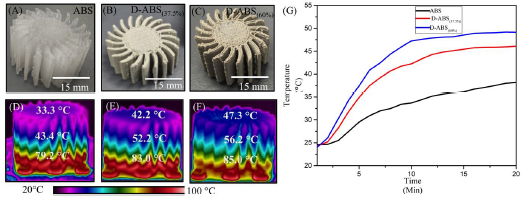Researchers at Australia’s ARC Centre of Excellence for Electromaterials Science (ACES) have published a study into the thermal performance of an ABS-diamond composite for 3D printers. The aim of the research is to broaden the selection of available materials for 3D printing, harnessing the unique properties of microdiamonds.
“Amongst the various carbonaceous fillers available, high pressure and high
temperature (HTHP) nano/micro-diamond possesses several attractive features, which have practical utility in a range of printable devices” explain the ACES team.
“These include its hydrophilicity, biocompatibility and non-toxicity, thermal stability, thermal conductivity, electrical insulation, (or indeed electrical conductivity in boron doped variants), hardness, wear resistance and low-cost.”
Microdiamonds are forever… being 3D printed
First created in 1963, microdiamond, and its little sister nanodiamond, are still seeking widespread commercial application.
Due to their range of favorable properties, both materials are incredibly versatile, and have shown great potential as an additive to lubricants, engine oil and polishes. At RMIT University nanodiamond has also recently proven to increase the biocompatibilty of 3D printed medical implants.
Specifically, microdiamond’s hydrophilic and thermal strengths are the features that stand out in this latest study from ACES.

Diamond ABS: a five-fold improvement on ABS alone
In experimentation, a microdiamond powder was homogeneously and densely distributed through ABS at 37.5 or 60 wt %. For the 60 t % filament, the most successful in this study, this ratio translates to 40 g of microdiamond to 26.5 g of ABS. 18
With this addition, the researchers report, “The thermal conductivity of the ABS base material increased from 0.17 to 0.94 W/(m·K),” this is “more than five-fold” the thermal conductivity of ABS alone. Further, “The elastic modulus for the 60 wt % microdiamond containing composite material increased by 41.9% with respect to pure ABS, from 1050 to 1490.” Hydrophilicity also demonstrated an increase by 32%.
Next, to 3D print diamond ABS, the team modified their desktop system (from Dutch company FELIXprinters) with titanium gears, which are more effective at resisting abrasion from composite particles. Heat sinks were then selected as an appropriate test object.
Printing with diamond filament. For details read our recently published article https://t.co/A8hr4Cg1gr@3DPrint_newsbot @ACS_AMI @ColorFabb @Carbodeon @DPrintGirl @Fillamentum @ChemistryWorld @3dprintingevent @3DPrintingJrnl @3dprintindustry @imaterialise @All3DP @3DPrint_com pic.twitter.com/28UCENGgYg
— Sidra (@SidraWaheeed) January 18, 2019
The potential for miniaturized electronics
According to results, “Heat dissipation measurements demonstrated that 3D printed heat sinks containing 60 % (wt) diamond increased the thermal dissipation by 42 %.”
Further, the researchers showed that any waste 3D prints made in this process were fully recyclable. After dissolving in acetone, pellets were formed and re-extruded as a filament. “Following this simple process,” the researchers stipulate, “it was noted that thermal conductivity was identical to the original filament,” though there was a 16% decrease in the elastic modulus.

Readily available from a variety of suppliers in China, it is also possible that microdiamond bought in high quantities could meet the low cost demands of this filament is developed commercially.
The paper concludes: “As electronics become smaller and more powerful, thermal management has become one of the key limiting factors in device performance […] this novel low cost micro-diamond containing ABS composite provides a potential practical solution,”
“In addition, its compatibility with FDM printing for production of complex geometries at lowcost could be of significant advantage in miniaturized and compact thermal management applications.”
The ARC team’s paper for this study, “3D printing of abrasive, hard and thermally conductive synthetic micro-diamond-polymer composite using low-cost fused deposition modelling printer,” is published online in ACS Applied Materials & Interfaces. It is co-authored by Sidra Waheed, Joan M. Cabot, Petr Smejkal, Syamak Farajikhah, Sepidar Sayyar, Peter C. Innis, Stephen Beirne, Grant Barnsley, Trevor W. Lewis, Michael C. Breadmore, and Brett Paull.
Is this your Research Team of the Year? Nominate ACES and more for the 2019 3D Printing Industry Awards.
For more 3D printing research updates subscribe to the 3D Printing Industry newsletter, like us on Facebook and follow us on Twitter. Consider 3D Printing Jobs for your next research opportunity.
Featured image shows distribution of microdiamond throughout extruded ABS. Image via ACS Applied Materials & Interfaces



